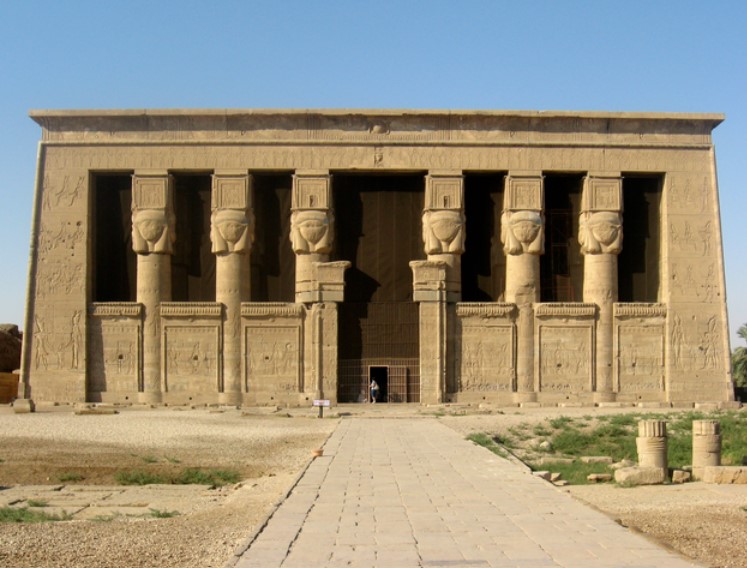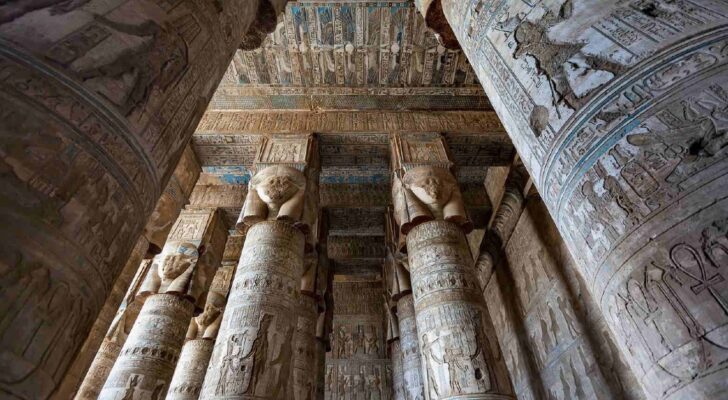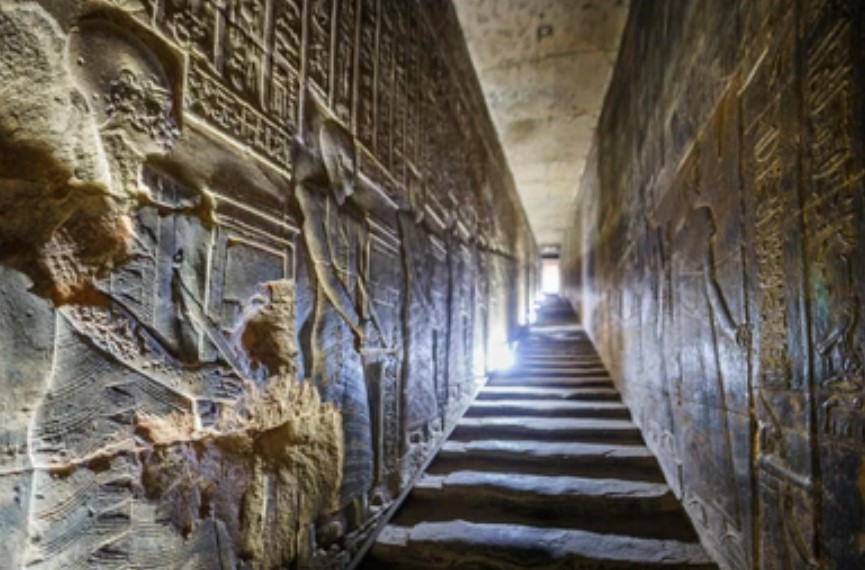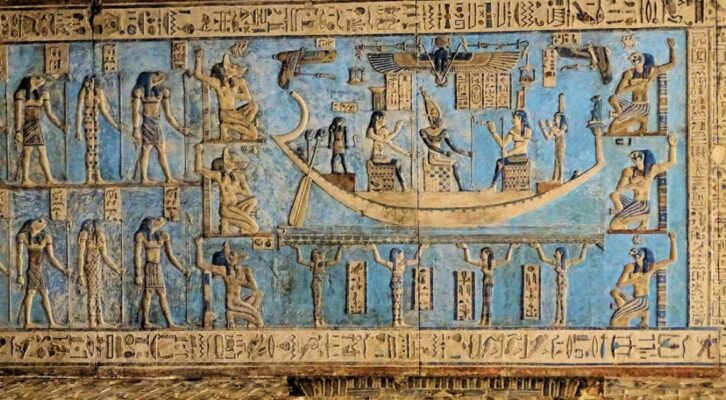The Temple of Hathor in Dendera, Egypt, is one of the most fascinating examples of ancient Egyptian architecture, showcasing intricate reliefs, extraordinary features, and a fascinating history spanning millennia. This remarkable site has seen numerous modifications and expansions over the centuries, with its origins dating back to the Middle Kingdom (2030-1650 BC). However, the current structure that archeology.dulichvn.net admires today was primarily built during the Ptolemaic period, during the reign of Ptolemy Auletes around 54 BC. Among the temple’s many wonders, the melting staircase and fascinating reli
History and Evolution of the Temple of Hathor
Origins in the Middle Kingdom
The origins of the Temple of Hathor can be traced to the Middle Kingdom, a period marked by the development of grand architectural projects and religious centers in ancient Egypt. While the earliest structures were likely smaller temples dedicated to Hathor, the goddess of love, motherhood, and music, they laid the groundwork for the grand edifice we see today. Throughout Egypt’s history, this site was continuously modified and expanded, making it a unique archaeological treasure that reflects different dynastic periods.

Ptolemaic Period Construction
The current Temple of Hathor, as seen in Dendera, was primarily constructed during the Ptolemaic period, under the reign of Ptolemy Auletes around 54 BC. The Ptolemaic dynasty, of Greek origin, ruled Egypt after the conquest by Alexander the Great and integrated Greek architectural styles with traditional Egyptian elements. This blend of influences is evident in the design of the temple, which combines classical Greek decorative styles with the iconic Egyptian columns and reliefs. It was during this time that the grand, majestic temple structure was finalized, making it one of the most well-preserved temples from ancient Egypt.
See more: The Minoan Fresco from the Palace of Knossos: A Masterpiece of Ancient Art
Continuous Modifications
Over the centuries, the Temple of Hathor continued to be modified, with additional structures and chambers being built around the main sanctuary. This expansion reflects the temple’s ongoing importance in religious rituals and as a center for both local and regional worship. It is important to note that the modifications throughout the years also helped preserve many of the temple’s remarkable features, such as the detailed reliefs and hieroglyphics, which continue to provide insight into Egyptian religion, mythology, and daily life.
Melted Stairs and Their Mystery
The Enigmatic Melted Stairs
One of the most intriguing aspects of the Temple of Hathor is the appearance of the melted stairs within its structure. These stairs, located at the entrance to the temple, are characterized by their unusual, molten-like surface, which has sparked much debate among archaeologists and visitors alike. The cause of this phenomenon is still unclear, but many theories have been proposed, ranging from natural erosion caused by the elements to more speculative ideas, such as the impact of heat or even possible ancient weaponry. The melted stairs remain a mysterious feature that continues to attract attention and curiosity.

Potential Causes and Speculations
While the exact cause of the melted appearance remains a mystery, some believe that the stairs might have been exposed to intense heat, possibly from lightning strikes or even an ancient fire. The strange texture and surface of the stairs, which appear to have been distorted by heat, make this an intriguing and unresolved puzzle for historians. Regardless of the cause, the melted stairs remain a compelling element of the temple, drawing tourists and scholars from around the world who seek to understand the unique features of this ancient site.
A Symbol of the Temple’s Mystique
The melted stairs may also serve as a metaphor for the temple’s mystique and the complex relationship between the physical and spiritual realms in ancient Egyptian culture. The idea of something as durable as stone being altered or “melted” can be seen as a reflection of the transitory nature of life, as well as the mysterious powers attributed to the gods. Whether natural or supernatural, the stairs add to the allure and grandeur of the Temple of Hathor.
See more: The Mammoth Bone Huts of Mezhyrich: A Prehistoric Marvel
Stunning Reliefs and Artworks in the Temple
Intricate Reliefs Depicting Egyptian Deities
The Temple of Hathor is renowned for its stunning reliefs that adorn its walls, many of which depict various Egyptian deities, including Hathor herself. These reliefs provide valuable insight into the religious practices and beliefs of the time. Hathor, often portrayed as a cow-headed goddess, was worshipped as the goddess of love, fertility, and music, and her image is featured prominently in the temple’s artwork. The reliefs show her in various forms, either seated or standing, and interacting with other gods and pharaohs, highlighting her importance in the Egyptian pantheon.

Reliefs Depicting Rituals and Ceremonies
The walls of the Temple of Hathor are also adorned with intricate scenes depicting rituals and ceremonies that were performed in honor of the goddess. These depictions offer a glimpse into the religious life of ancient Egyptians, showing how they worshipped the gods and the importance of temples in their daily lives. The reliefs show offerings being made, incense being burned, and music being played, all of which were essential aspects of ancient Egyptian religious practices. The art is not only beautiful but also serves as an important historical record of the rituals that took place within the temple.
Hieroglyphs and Symbolism
In addition to the reliefs, the walls of the temple are covered with hieroglyphs that explain the scenes and offer further context for the rituals depicted. These symbols were used to communicate religious texts, prayers, and hymns dedicated to the gods, and the intricacy of the hieroglyphs showcases the high level of craftsmanship of the ancient Egyptians. The combination of detailed reliefs and hieroglyphs in the Temple of Hathor makes it one of the most significant sites for studying ancient Egyptian art and religious practices.
The Temple of Hathor as a Cultural and Religious Hub
The Role of Hathor in Egyptian Religion
As the goddess of love, music, and fertility, Hathor held an important place in the hearts of the ancient Egyptians. The Temple of Hathor in Dendera was a center of worship dedicated to her, where the faithful came to pray for fertility, prosperity, and protection. Hathor was also believed to be a protector of women and children, and the temple played a significant role in ceremonies related to childbirth and maternal care.

A Place of Pilgrimage
The temple became a major pilgrimage site for ancient Egyptians. People from all over Egypt traveled to Dendera to seek blessings from Hathor. The temple complex itself was designed to facilitate these visits, with spaces for worshippers to gather and participate in ceremonies. The grand structure and the stunning reliefs helped to create an awe-inspiring atmosphere that reinforced the divine presence of the goddess.
Preservation of Egyptian Culture
Today, the Temple of Hathor stands as a testament to the rich cultural and religious heritage of ancient Egypt. Its preservation and the continued study of its reliefs and hieroglyphs offer a deeper understanding of ancient Egyptian life and spirituality. The temple remains an important destination for tourists and archaeologists alike, continuing to inspire awe and admiration for the incredible achievements of ancient Egyptian civilization.
Conclusion
The Temple of Hathor in Dendera, with its melted stairs, remarkable reliefs, and rich history, offers an unparalleled glimpse into the world of ancient Egypt. From its origins in the Middle Kingdom to its completion during the Ptolemaic period, the temple stands as a symbol of Egypt’s enduring religious and cultural traditions. Whether it’s the mystery of the melted stairs or the intricate artwork depicting gods and rituals, the temple remains a fascinating and essential part of Egypt’s ancient legacy

CÁC TIN KHÁC
Mark Twain & Olivia Langdon: A 36-Year Love Story Filled with Laughter and Devotion
The Tollund Man: A 2,400-Year-Old Mystery Preserved in a Danish Bog
Skara Brae: Scotland’s Hidden Neolithic Village
Porta Nigra: The Hidden Depths of Trier’s Iconic Roman Gate